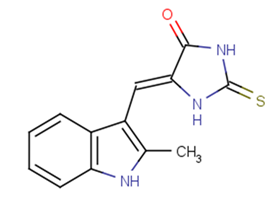
PKG drug G1
CAS No. 374703-78-3
PKG drug G1( —— )
Catalog No. M18488 CAS No. 374703-78-3
PKG drug G1 targets C42 of PKG Iα. PKG drug G1 can couple to vasodilation and blood pressure lowering by a C42 PKG Iα-independent mechanism.
Purity : >98% (HPLC)
 COA
COA
 Datasheet
Datasheet
 HNMR
HNMR
 HPLC
HPLC
 MSDS
MSDS
 Handing Instructions
Handing Instructions
| Size | Price / USD | Stock | Quantity |
| 2MG | 46 | In Stock |


|
| 5MG | 72 | In Stock |


|
| 10MG | 110 | In Stock |


|
| 25MG | 177 | In Stock |


|
| 50MG | 335 | In Stock |


|
| 100MG | 500 | In Stock |


|
| 500MG | 1098 | In Stock |


|
| 1G | Get Quote | In Stock |


|
Biological Information
-
Product NamePKG drug G1
-
NoteResearch use only, not for human use.
-
Brief DescriptionPKG drug G1 targets C42 of PKG Iα. PKG drug G1 can couple to vasodilation and blood pressure lowering by a C42 PKG Iα-independent mechanism.
-
DescriptionPKG drug G1 targets C42 of PKG Iα. PKG drug G1 can couple to vasodilation and blood pressure lowering by a C42 PKG Iα-independent mechanism.
-
In Vitro——
-
In VivoPKG drug G1 induces vasodilation of isolated resistance blood vessels and blood pressure lowering in a mouse model of angiotensin II–induced hypertension. PKG drug G1 efficiently relaxes WT but not knockin (KI) vessels, which is then assessed in a murine model of hypertension. PKG drug G1 lowers blood pressure in hypertensive WT, but not KI, mice in vivo. PKG drug G1 is tested in vivo in healthy mice implanted with telemetric devices that allow blood pressure and heart rate to be constantly monitored. PKG drug G1 or vehicle control is administrated by intraperitoneal injection, and the acute impact on hemodynamics assessed. PKG drug G1 administered at 7.4 mg/kg does not decrease blood pressure, but there is a concomitant reflex tachycardia. When this is repeated using 14.8 mg/kg dose of PKG drug G1, again blood pressure is not altered-but this higher dose induces a potentiated increase in heart rate.
-
Synonyms——
-
PathwayOthers
-
TargetOther Targets
-
RecptorPKG Iα
-
Research AreaCardiovascular Disease
-
Indication——
Chemical Information
-
CAS Number374703-78-3
-
Formula Weight257.31
-
Molecular FormulaC13H11N3OS
-
Purity>98% (HPLC)
-
SolubilityDMSO : ≥ 103 mg/mL; 400.30 mM
-
SMILESS=C3N/C(=C\c1c(C)nc2ccccc12)C(=O)N3
-
Chemical Name——
Shipping & Storage Information
-
Storage(-20℃)
-
ShippingWith Ice Pack
-
Stability≥ 2 years
Reference
1.Burgoyne JR, et al. Proof of Principle for a Novel Class of Antihypertensives That Target the Oxidative Activation of PKG Iα (Protein Kinase G Iα). Hypertension. 2017 Sep;70(3):577-586.
molnova catalog



related products
-
Histatin 5 (TFA)
Histatin 5 TFA inhibits the activity of the host matrix metalloproteinases MMP-2 and MMP-9 with IC50s of 0.57 and 0.25 μM, respectively.
-
Speract
Speract is a sea urchin egg peptide that regulates sperm motility also stimulates sperm mitochondrial metabolism.
-
5-Methyl-2-furaldehy...
5-Methylfurfural has been identified as one of the volatile flavor compounds in tamarind, Dutch Coffee, barrel-aged wines and deep fat-fried soybeans.



 Cart
Cart
 sales@molnova.com
sales@molnova.com


